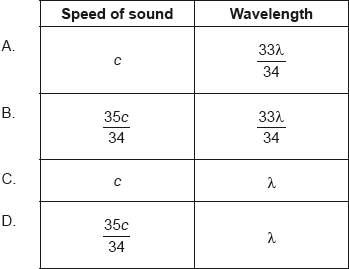| Date | May 2022 | Marks available | 2 | Reference code | 22M.2.HL.TZ1.3 |
| Level | Higher level | Paper | Paper 2 | Time zone | 1 |
| Command term | Determine | Question number | 3 | Adapted from | N/A |
Question
Two loudspeakers A and B are initially equidistant from a microphone M. The frequency and intensity emitted by A and B are the same. A and B emit sound in phase. A is fixed in position.
B is moved slowly away from M along the line MP. The graph shows the variation with distance travelled by B of the received intensity at M.
Explain why the received intensity varies between maximum and minimum values.
State and explain the wavelength of the sound measured at M.
B is placed at the first minimum. The frequency is then changed until the received intensity is again at a maximum.
Show that the lowest frequency at which the intensity maximum can occur is about 3 kHz.
Speed of sound = 340 m s−1
Loudspeaker A is switched off. Loudspeaker B moves away from M at a speed of 1.5 m s−1 while emitting a frequency of 3.0 kHz.
Determine the difference between the frequency detected at M and that emitted by B.
Markscheme
movement of B means that path distance is different « between BM and AM »
OR
movement of B creates a path difference «between BM and AM» ✓
interference
OR
superposition «of waves» ✓
maximum when waves arrive in phase / path difference = n x lambda
OR
minimum when waves arrive «180° or » out of phase / path difference = (n+½) x lambda ✓
wavelength = 26 cm ✓
peak to peak distance is the path difference which is one wavelength
OR
this is the distance B moves to be back in phase «with A» ✓
Allow 25 – 27 cm for MP1.
«» = 13 cm ✓
«» 2.6 «kHz» ✓
Allow ½ of wavelength from (b) or data from graph for MP1.
Allow ECF from MP1.
ALTERNATIVE 1
use of (+ sign must be seen) OR = 2987 «Hz» ✓
« » = 13 «Hz» ✓
ALTERNATIVE 2
Attempted use of ≈
« Δf » = 13 «Hz» ✓
Examiners report
This was an "explain" questions, so examiners were looking for a clear discussion of the movement of speaker B creating a changing path difference between B and the microphone and A and the microphone. This path difference would lead to interference, and the examiners were looking for a connection between specific phase differences or path differences for maxima or minima. Some candidates were able to discuss basic concepts of interference (e.g. "there is constructive and destructive interference"), but failed to make clear connections between the physical situation and the given graph. A very common mistake candidates made was to think the question was about intensity and to therefore describe the decrease in peak height of the maxima on the graph. Another common mistake was to approach this as a Doppler question and to attempt to answer it based on the frequency difference of B.
Many candidates recognized that the wavelength was 26 cm, but the explanations were lacking the details about what information the graph was actually providing. Examiners were looking for a connection back to path difference, and not simply a description of peak-to-peak distance on the graph. Some candidates did not state a wavelength at all, and instead simply discussed the concept of wavelength or suggested that the wavelength was constant.
This was a "show that" question that had enough information for backwards working. Examiners were looking for evidence of using the wavelength from (b) or information from the graph to determine wavelength followed by a correct substitution and an answer to more significant digits than the given result.
Many candidates were successful in setting up a Doppler calculation and determining the new frequency, although some missed the second step of finding the difference in frequencies.


